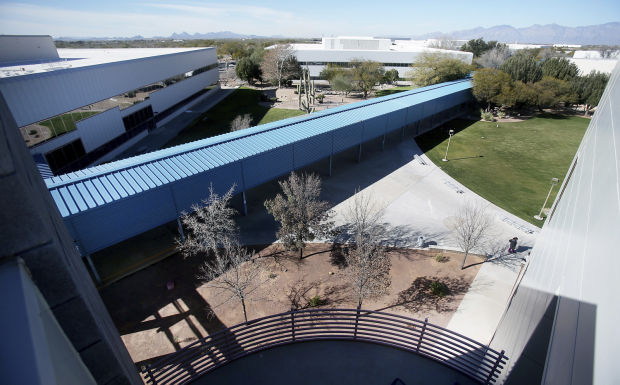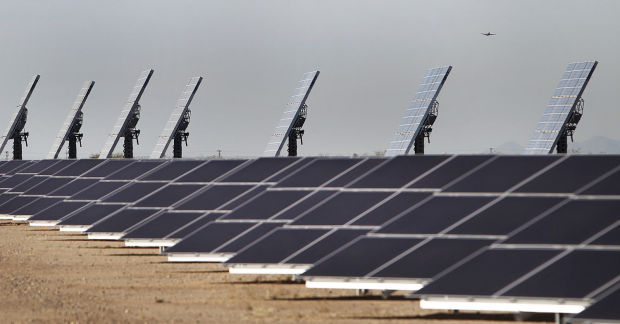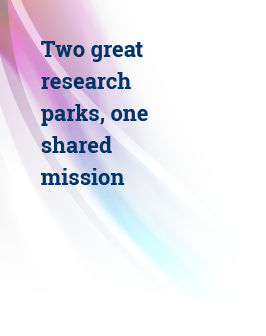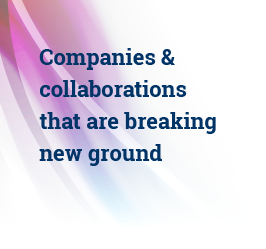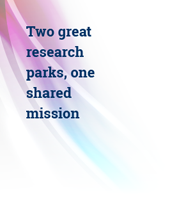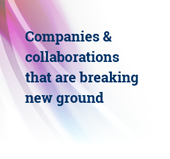New plans in the works for UA tech parks
Published By: The Arizona Daily Star
Article By: David Wichner
Photos By: Mike Christy
Whitney Moreland, a customer advocate with Optum Rx, takes a break |
The UA Tech Park on the southeast side is also home to the Solar Zone, |
Photo-voltaic solar arrays make up The Solar Zone on the campus |
Just off Interstate 10, the University of Arizona Science and Technology Park sprawls across the desert, a bustling complex where some 7,000 workers report to work everyday at companies including tech giants IBM and Raytheon.
Some 13 miles to the northwest, the UA’s Arizona Biosciences Park sits empty, its dirt landscape barren except for some fancy signage and the occasional dust devil.
Changes are underway at both parks as the UA continues to retool its technology commercialization efforts under Tech Launch Arizona.
After failing to attract a major bio-tenant that would partner with building the first building at the Bio Park, the UA will broaden the scope of the project to embrace all technologies — with a pending name change as well, said Bruce Wright, UA associate vice president for university research parks.
Meanwhile, the UA is working on a new strategic plan for the Tech Park, which is mostly leased but has acres of land shovel-ready for development. And the Arizona Center for Innovation, a business incubator at the Tech Park, is getting a new focus as well.
Wright said the changes are part of several UA initiatives, beginning with “Never Settle,” a sweeping plan for the UA unveiled by UA President Ann Weaver Hart last November that among other things calls for expanded faculty and research and more partnerships with businesses.
Then there is Tech Launch Arizona and its strategic plan, which already has resulted in the renaming of the UA’s tech-park enterprise to simply Tech Parks Arizona (and the shorthand brands, UA Tech Park and UA Bio Park) and an ongoing review of how the tech parks fit into the grander vision for the school.
The new strategic plan for the Tech Park is a top-to-bottom review focused on meshing the park’s activities with the UA’s goals, Wright said.
“This has been a particularly intensive and sophisticated effort to make sure what we’re doing in the tech parks is aligned with the goals of the university,” said Wright. “It’s more than just a new branding and a new marketing campaign.”
The last major master plan for the Tech Park was floated in 2002, with some revisions in 2004 to allow for a hotel and conference center that never materialized.
Though the strategic plans have not been finalized, Wright said one plan is to expand the focus of the Arizona Center for Innovation to offer its space and services beyond startups to established companies, adding the role of a business “accelerator” to what has been mainly a startup incubator.
The new plan also will incorporate the Tech Park’s successful Solar Zone demonstration area, and the park’s more recent focus on border-security technology.
There’s no name change in the works for the Tech Park, but the UA is planning to rename the Bio Park in the next few months to reflect a wider technological focus, Wright said.
The UA has had serious discussions with several biotech companies, including some site visits, about locating at the Bio Park since the concept was approved in 2006.
After a complicated land swap gave the UA the Bio Park land at East 36th Street and Kino Parkway, a $4.7 million federal stimulus grant allowed the UA to clear the land and lay infrastructure. A Costco and a Walmart were built on adjoining land as part of The Bridges mixed-use development, and two homebuilders are planning to soon start building houses on the adjacent housing tract there.
But amid the recession and its still-lingering aftermath, the search for a biotech anchor tenant or a development partner has proved fruitless.
The recession didn’t help, and the UA found the biopark concept too narrow, Wright aid.
“It needs to have its focus broadened and widened to include all technology, not just biotech,” he said.
The UA will now focus its efforts to finding a development partner to build an initial, mixed-use building, Wright said, adding that he believes a couple of companies would have come if space was ready.
That doesn’t mean the UA has stopped courting bioscience firms.
“We’re out there trying to recruit biotech companies to the area, and we still see that as a really important part of university’s technology portfolio,” Wright said. “We’re not backing away from any of this.”
Wright’s boss, Tech Launch Arizona Vice President David Allen, said he’s looking to strengthen ties between the tech parks and the university.
“We are looking to the Tech Park to have a much greater role with the university in general,” said Allen, citing the park’s new marketing slogan, “Interactive Ground.”
An example of that, Allen said, is the Solar Zone, which has been built out with six sites including various solar-energy technologies that allow UA solar researchers to study system design and performance.
Allen said recasting the Bio Park in a wider light makes more sense than limiting the market, but he said the nascent park shouldn’t be considered a failure.
“I don’t think it’s a failure, in that the university received the land at virtually no cost, partnered with the county and then partnered with the federal government to put the infrastructure in, and we’re shovel-ready,” Allen said. “People say, ‘well, there should be more there.’ But we’re coming out of a recession, and there haven’t been a lot of new companies that have moved to this area.”
Attracting companies that have or are interested in ties with the UA through technology licensing, sponsored research, internships or clinical work will be a “high-level priority” for the Bio Park, Allen said.
“The vast majority, and I hope it is the totality, of the companies that are going to be new to the tech parks are going to have a relationship with the university,” Allen said.



